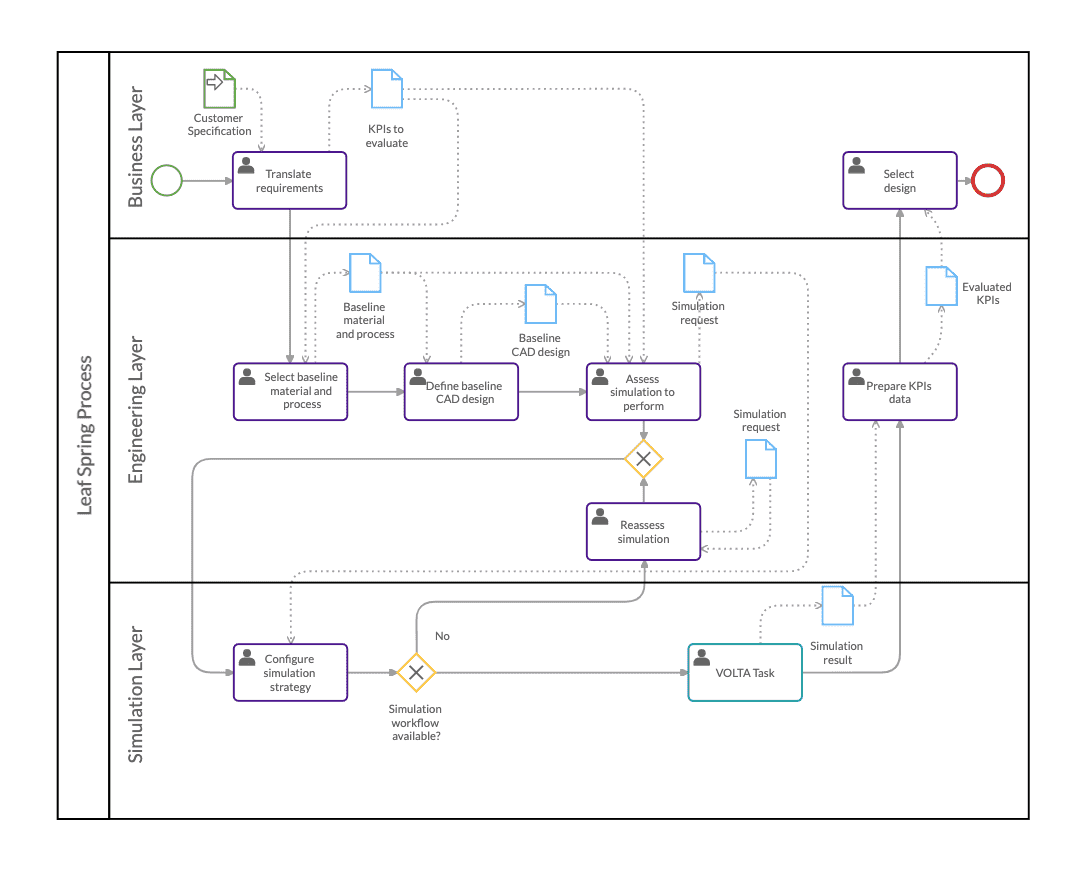Why we chose to rely on BPMN for ESTECO Technology
Written by Nela Lazarevic
30 September 2021 · 8 min read

Cardanit is a relatively new product but behind it there is a software company with over 20 years of experience producing workflow-based engineering solutions.
The very idea to create a tool for business process mapping was born in ESTECO’s Research and Development Department out of the need to study which business process modeling standard is the most robust, most versatile and most user-friendly, with the idea of bringing it into ESTECO core products aimed at solutions for the engineering design phase.
For several years researchers of the R&D department have studied, examined and tried hands-on virtually every possible solution for mapping business processes available on the market and in academia. What they’ve come up with is that the Business Process Model and Notation (BPMN) standard is the best there is.
Simulation-driven engineering design process is extremely complex and articulated. It requires streamlining repeatable processes across departments while incorporating multiple CAD, CAE and simulation tools, managing the data they produce and their passage from one step to another, from one domain-expert to another.
One of the reasons why BPMN turned out to be the right solution is the fact that it takes into account the division of the processes by roles, departments or even different companies. BPMN enables each user to focus on their part of the process, and on their particular view, while at the same time seeing how what they do is connected with the bigger picture. Division by lanes and pools in BPMN is perfect for this kind of need.
Another key aspect is the recognition of the task type. The engineering design process is composed of machine-operated tasks, like simulation software running in loops, and human-operated tasks like configuring the simulation workflows or preparing reports. Streamlining the interaction between these types of tasks can make a difference in terms of time and resources necessary to complete projects and come up with innovative designs. BPMN distinguishes a human task from a machine-operated task, business rule or a script-operated task, which has great benefits when it comes to process automation.
BPMN also excels in representing complex processes in a compact manner. Not everyone in the organization needs to see the sequence including every single step of the operational tasks, but for process users it is essential to have all the details that impact their work. BPMN workflows don’t make you compromise with either - tasks that are not of essential value for the high level views, usually referred to by decision makers, are collapsed. By clicking on a particular task, a detailed subprocess view expands, making it easy to have all the details and a compact process model in one. Articulated processes that run across several engineering disciplines and departments can largely benefit from this kind of compact yet all-encompassing mapping.

But our colleagues were not looking just for a set of all the right features for the needs of the engineering design teams. They also wanted a widely used, reliable standard that would be relatively easy to grasp and that has readily available literature for those who want to become expert users. BPMN came out as the winner in this area, too. Managed by the OMG group, BPMN has become the de facto standard for business process modeling, preferred and trusted by business analysts and consultants across the globe. It was designed with automation of complex processes in mind and as a modeling language that should put business people and IT on the same page.
For business people, BPMN 2.0 diagrams are like software in pictures - every task they map contains the automatically inscribed XML code in the background, making it runnable with little or no input from the IT side. Legacy practice of mapping process automations with in-house code makes these systems inaccessible to anyone outside of the IT departments and even the slightest change impacts the entire design. BPMN models are flexible and scalable because it is possible to impact the aspects of the subprocess without collateral effects on the high-level processes - another valuable feature in a fast-paced environment like that of the engineering design teams. Finally, the extensive official documentation, along with the vast literature available on the subject also made BPMN the obvious choice for ESTECO Technology.
How it works
VOLTA is used as the Simulation Process and Data Management platform by the big players in the aerospace and automotive industry. Explained simply, it’s a web-based enterprise platform that brings people, processes and technology together, providing a single source of truth for all the information regarding the simulation-based engineering design process. This includes complex simulation workflows comprising multiple third-party engineering software, data management functionalities with tiered access and advanced versioning, and job-scheduling features to efficiently distribute the heavy workloads of simulation processes.
Engineering design projects consist of human, machine and automated script tasks. Their effective orchestration can make a difference between a successful endeavor and a suboptimal use of time and resources.
The machine-operated tasks were already handled in a state-of-the art manner by the simulation workflow engine available in VOLTA, which builds upon 20 years of technology advancements of its sister product, modeFRONTIER, used by top car manufacturers like Toyota and Ford Motor company, and in many other industries.
What was missing in the equation is the incorporation of human-operated tasks and duties on top of the simulation workflow handling capabilities. In other words, the business process view was missing. And this is what BPMN is now bringing to the table.
The journey into the world of business process management started in 2012 for the ESTECO R&D team. Out of their insights, Cardanit was born in 2015, first known as BeePMN. A lot has happened since then. We’re now on the way to bringing exciting new technologies and features into Cardanit. But at the same time, these days it feels like this adventure has come full circle with BPM technology officially being released as part of VOLTA with the fall software release. The journey has just begun because over the years to follow BPM modules in VOLTA will keep becoming more and more advanced.
Starting with the current release, users will be able to use the VOLTA Modeler environment to map their procedures, prepare repetitive tasks for automated flows, and document their best practices for standardised and repetitive use. Once mapped, these processes will stay readily available across the enterprise. VOLTA Process Manager is the environment from which the users will be able to select and run instances of these processes whenever they need them. ESTECO technology has always been part of the Cardanit core, but now there’s officially a part of Cardanit within the ESTECO technologies.
Further reading
To find out more about VOLTA: esteco.com/VOLTA
To learn about the use of ESTECO BPM technology in the engineering industry: Composelector
How to successfully build a business process simulation model with BPSim


With a background in journalism, Nela Lazarevic worked as a Communications Specialist and Digital Marketing Specialist at ESTECO, the mother company of Cardanit, from 2016 to 2022.
With a background in journalism, Nela Lazarevic worked as a Communications Specialist and Digital Marketing Specialist at ESTECO, the mother company of Cardanit, from 2016 to 2022.
Learn how to effectively represent data in your BPMN diagrams, create reliable data models and design processes that align with your organizational goals.
Do you know how to model data in BPMN?
Learn how to effectively represent data in your BPMN diagrams, create reliable data models and design processes that align with your organizational goals.
Do you know how to model data in BPMN?
Learn how to effectively represent data in your BPMN diagrams, create reliable data models and design processes that align with your organizational goals.
